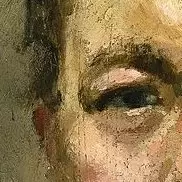I and the Village is a “narrative self-portrait” featuring memories of Marc Chagall’s childhood in the town of Vitebsk, in Russia. The dreamy painting is ripe with images of the Russian landscape and symbols from folk stories. The picture can be broken down into five distinct sections. The first at the top right includes a rendering of Chagall’s home town, with a church, a series of houses and two people. The woman and some of the houses in the village are upside down, further emphasizing the dreamlike quality of the work. Below that we see a green-faced man who some say is Chagall himself. At the bottom of the work, we see a hand holding a flowering branch. Next to that, an object which some say is a child’s bouncing ball - perhaps a plaything from Chagall’s earlier days. Finally, we see the image of a milkmaid layered atop the head of a lamb - a motif common to Chagall. (Cows, bulls and lambs figure in many of Chagall’s paintings as cosmic symbols).
The important thing to note about this picture is that it is a reflection of Marc Chagall’s dreams and memories. Also relevant is the fact that many of Chagall’s pictures (including this one) have symbols that relate specifically to Jewish folklore.

